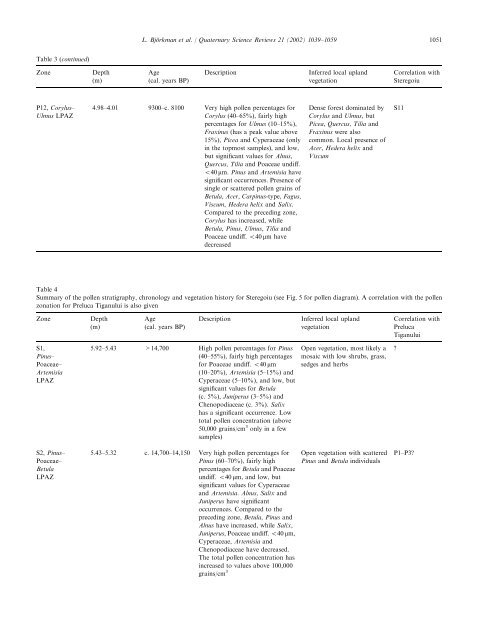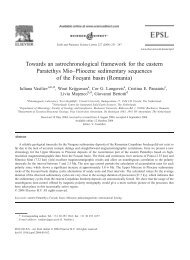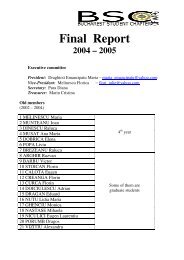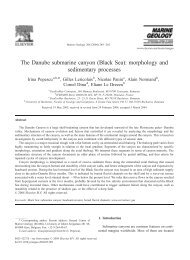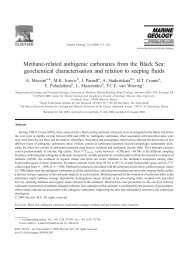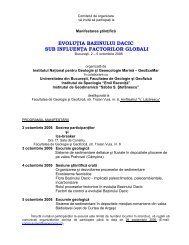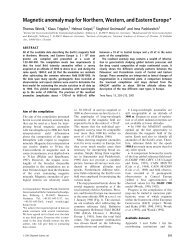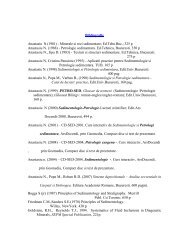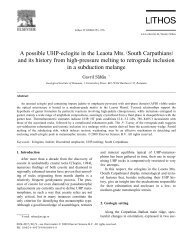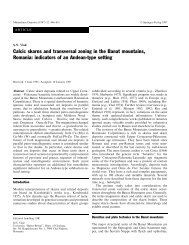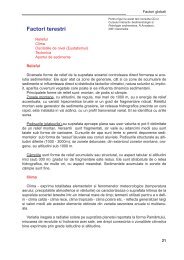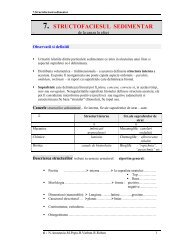Lateglacial and early Holocene vegetation ... - geo.edu.ro
Lateglacial and early Holocene vegetation ... - geo.edu.ro
Lateglacial and early Holocene vegetation ... - geo.edu.ro
Create successful ePaper yourself
Turn your PDF publications into a flip-book with our unique Google optimized e-Paper software.
L. Bj .orkman et al. / Quaternary Science Reviews 21 (2002) 1039–1059 1051<br />
Table 3 (continued)<br />
Zone<br />
Depth<br />
(m)<br />
Age<br />
(cal. years BP)<br />
Description<br />
Inferred local upl<st<strong>ro</strong>ng>and</st<strong>ro</strong>ng><br />
<st<strong>ro</strong>ng>vegetation</st<strong>ro</strong>ng><br />
Correlation with<br />
Steregoiu<br />
P12, Corylus–<br />
Ulmus LPAZ<br />
4.98–4.01 9300–c. 8100 Very high pollen percentages for<br />
Corylus (40–65%), fairly high<br />
percentages for Ulmus (10–15%),<br />
Fraxinus (has a peak value above<br />
15%), Picea <st<strong>ro</strong>ng>and</st<strong>ro</strong>ng> Cyperaceae (only<br />
in the topmost samples), <st<strong>ro</strong>ng>and</st<strong>ro</strong>ng> low,<br />
but significant values for Alnus,<br />
Quercus, Tilia <st<strong>ro</strong>ng>and</st<strong>ro</strong>ng> Poaceae undiff.<br />
o40 mm. Pinus <st<strong>ro</strong>ng>and</st<strong>ro</strong>ng> Artemisia have<br />
significant occurrences. Presence of<br />
single or scattered pollen grains of<br />
Betula, Acer, Carpinus-type, Fagus,<br />
Viscum, Hedera helix <st<strong>ro</strong>ng>and</st<strong>ro</strong>ng> Salix.<br />
Compared to the preceding zone,<br />
Corylus has increased, while<br />
Betula, Pinus, Ulmus, Tilia <st<strong>ro</strong>ng>and</st<strong>ro</strong>ng><br />
Poaceae undiff. o40 mmhave<br />
decreased<br />
Dense forest dominated by<br />
Corylus <st<strong>ro</strong>ng>and</st<strong>ro</strong>ng> Ulmus, but<br />
Picea, Quercus, Tilia <st<strong>ro</strong>ng>and</st<strong>ro</strong>ng><br />
Fraxinus were also<br />
common. Local presence of<br />
Acer, Hedera helix <st<strong>ro</strong>ng>and</st<strong>ro</strong>ng><br />
Viscum<br />
S11<br />
Table 4<br />
Summary of the pollen stratigraphy, ch<strong>ro</strong>nology <st<strong>ro</strong>ng>and</st<strong>ro</strong>ng> <st<strong>ro</strong>ng>vegetation</st<strong>ro</strong>ng> history for Steregoiu (see Fig. 5 for pollen diagram). A correlation with the pollen<br />
zonation for Preluca Tiganului is also given<br />
Zone<br />
Depth<br />
(m)<br />
Age<br />
(cal. years BP)<br />
Description<br />
Inferred local upl<st<strong>ro</strong>ng>and</st<strong>ro</strong>ng><br />
<st<strong>ro</strong>ng>vegetation</st<strong>ro</strong>ng><br />
Correlation with<br />
Preluca<br />
Tiganului<br />
S1,<br />
Pinus–<br />
Poaceae–<br />
Artemisia<br />
LPAZ<br />
S2, Pinus–<br />
Poaceae–<br />
Betula<br />
LPAZ<br />
5.92–5.43 >14,700 High pollen percentages for Pinus<br />
(40–55%), fairly high percentages<br />
for Poaceae undiff. o40 mm<br />
(10–20%), Artemisia (5–15%) <st<strong>ro</strong>ng>and</st<strong>ro</strong>ng><br />
Cyperaceae (5–10%), <st<strong>ro</strong>ng>and</st<strong>ro</strong>ng> low, but<br />
significant values for Betula<br />
(c. 5%), Juniperus (3–5%) <st<strong>ro</strong>ng>and</st<strong>ro</strong>ng><br />
Chenopodiaceae (c. 3%). Salix<br />
has a significant occurrence. Low<br />
total pollen concentration (above<br />
50,000 grains/cm 3 only in a few<br />
samples)<br />
5.43–5.32 c. 14,700–14,150 Very high pollen percentages for<br />
Pinus (60–70%), fairly high<br />
percentages for Betula <st<strong>ro</strong>ng>and</st<strong>ro</strong>ng> Poaceae<br />
undiff. o40 mm, <st<strong>ro</strong>ng>and</st<strong>ro</strong>ng> low, but<br />
significant values for Cyperaceae<br />
<st<strong>ro</strong>ng>and</st<strong>ro</strong>ng> Artemisia. Alnus, Salix <st<strong>ro</strong>ng>and</st<strong>ro</strong>ng><br />
Juniperus have significant<br />
occurrences. Compared to the<br />
preceding zone, Betula, Pinus <st<strong>ro</strong>ng>and</st<strong>ro</strong>ng><br />
Alnus have increased, while Salix,<br />
Juniperus, Poaceae undiff. o40 mm,<br />
Cyperaceae, Artemisia <st<strong>ro</strong>ng>and</st<strong>ro</strong>ng><br />
Chenopodiaceae have decreased.<br />
The total pollen concentration has<br />
increased to values above 100,000<br />
grains/cm 3<br />
Open <st<strong>ro</strong>ng>vegetation</st<strong>ro</strong>ng>, most likely a<br />
mosaic with low shrubs, grass,<br />
sedges <st<strong>ro</strong>ng>and</st<strong>ro</strong>ng> herbs<br />
Open <st<strong>ro</strong>ng>vegetation</st<strong>ro</strong>ng> with scattered<br />
Pinus <st<strong>ro</strong>ng>and</st<strong>ro</strong>ng> Betula individuals<br />
?<br />
P1–P3?


